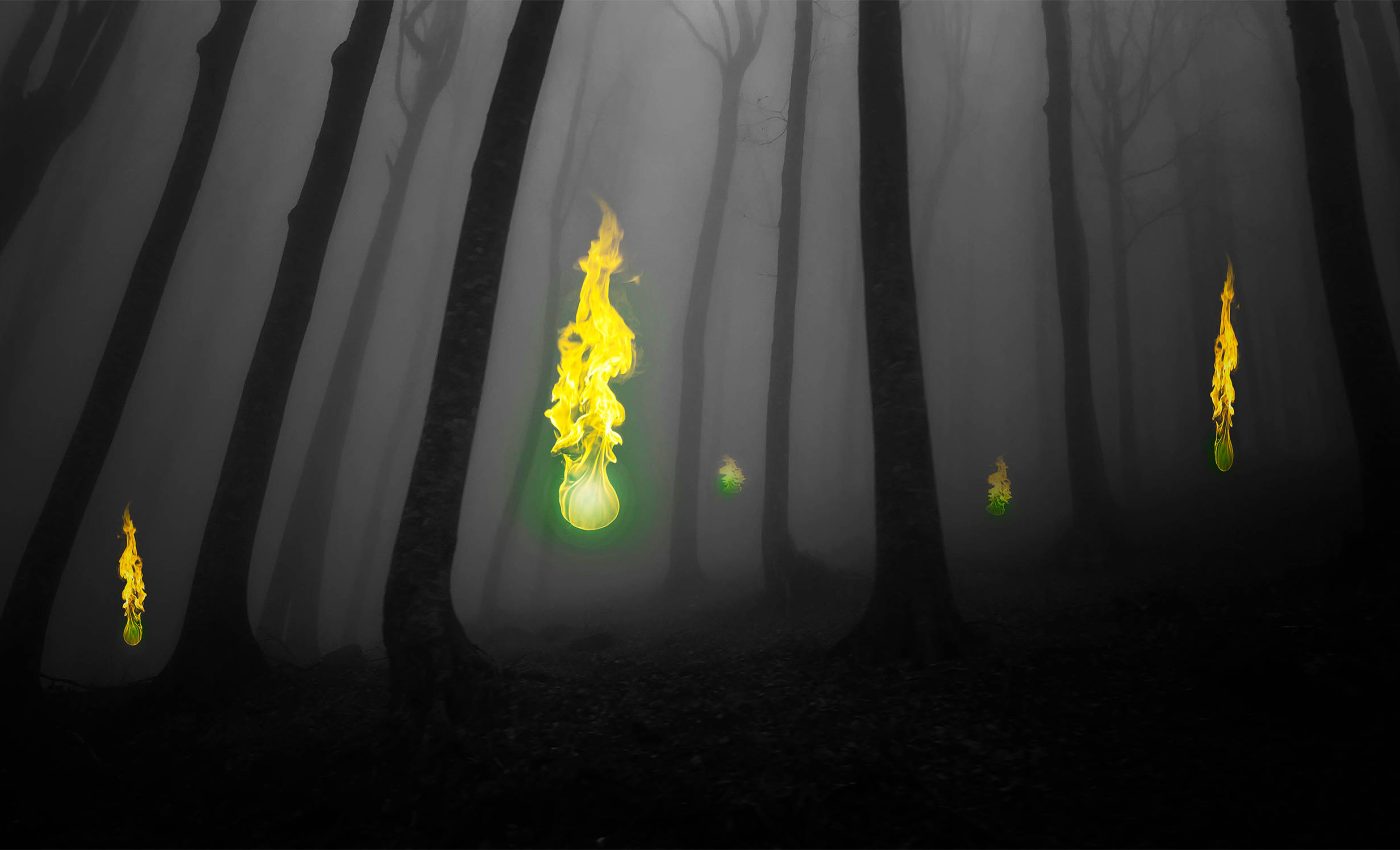
Flashes of eerie light in swamplands, called will-o’-the-wisps, have eluded explanation for centuries
For centuries, travelers reported strange blue flames flickering across marshes and wetlands at night. These ghostly lights – called ignis fatuus or “will-o’-the-wisps” – fed legends of spirits luring wanderers into danger.
Scientists later guessed the lights came from methane flames. But one question remained: What ignited the methane?
A new study finally answers that puzzle.
Researchers from the University of Pennsylvania show that “microlightning” flashes can spark between tiny methane bubbles in water. Those flashes are enough to trigger methane oxidation under normal conditions.
“Will-o’-the-wisps” legends explained
Travelers would see these ghostly blue or greenish glows and think they were spirits trying to lead them astray.
Many legends warned that if you followed the lights, you might wander into dangerous bogs or get hopelessly lost.
In European folklore, especially in England, Ireland, and Scandinavia, people believed these lights were mischievous fairies, spirits of the dead, or even the souls of the unbaptized, playing tricks on the living.
The stories gave people a way to explain strange sights in the dark before science offered another explanation.
Today we understand that will-o’-the-wisps are not supernatural, but natural chemical reactions. But to someone walking through the night centuries ago, this would have looked otherworldly.
This legend is a prime example of how people used imagination to explain phenomena they didn’t yet understand.
Searching for will-o’-the-wisps
Marshes release methane from rotting plants. Methane burns with a cool blue flame. That explains the color of will-o’-the-wisps but not their ignition.
Methane needs a big push to burn – the activation energy is over 100 kilocalories per mole. No campfire exists in a swamp. No match strikes itself in the night. Past explanations tried to fill the gap.
Some argued for phosphine gases. Others blamed static electricity in the air. None solved the puzzle. The new work finds the ignition source hidden in the bubbles themselves.
A bubble is not just air trapped in water. Its curved surface stores charge. When bubbles move or collide, charges separate. If two oppositely charged bubbles approach, the electric field in the thin gap between them spikes.
That field can break down the gas and release a discharge. In other words, the bubbles spark.
The researchers built a transparent tank with a nozzle to release methane–air bubbles into water. High-speed cameras recorded the process, and sensors captured both light and heat.
The results were clear: flashes appeared between bubbles in less than a millisecond. The group named this effect microlightning.
Microlightning starts cool flames
Microlightning alone is fascinating, but the real question is what it does to methane. The experiments provided the answer.
High-speed optical spectra showed emissions between 330 and 370 nanometers. That range signals excited molecules such as formaldehyde and hydroxyl radicals. These compounds form in cool flames.
Temperature sensors inside the water rose higher than pump heat alone could explain. Something chemical was releasing energy.
Gas analysis confirmed the change: methane and oxygen levels dropped, and carbon dioxide increased. Oxidation had started in plain water, without an external flame.
Will-o’-the-wisps hold climate lessons
The results finally explain how will-o’-the-wisps can flicker in wetlands. No trickery, no phosphine gas required. Just sparks hidden between bubbles.
The work also shows how powerful interfacial chemistry can be. Small electrical discharges at gas–water boundaries are enough to drive reactions.
That matters for more than folklore. Wetlands are huge methane sources. Understanding how sparks influence methane release could sharpen climate models.
The idea also stretches into industry. Engineers might use microlightning to design reactors that trigger reactions at lower energy costs.
Systems full of bubbles – whether in water treatment or chemical production – could behave in unexpected ways once charge effects are considered.
Myth meets measurement
Legends once treated will-o’-the-wisps as spirits or omens. This study proves the lights are chemistry at work. Yet the explanation does not make the lights less strange. It makes them more real.
Nature hides sparks at microscopic scales, unseen but powerful enough to set gas alight. A mystery once blamed on folklore now rests on physics and chemistry.
More sparks, more questions
The discovery raises more questions. Could microlightning happen in ocean spray or volcanic lakes? Does it affect methane release at a global scale?
Could other unexplained natural lights – once labeled as static or random combustion – also stem from electrified bubbles?
Scientists now wonder if these tiny sparks influence not just swamp gases, but also chemical reactions in the sea, lakes, or even industrial systems filled with bubbles.
If so, microlightning could play a quiet role in climate, weather, and the way natural gases move through our atmosphere.
This finding also suggests that other mysterious glowing events, long left unexplained, might share the same hidden cause.
Each bubble burst in a swamp may hold an answer, and with it, a new path to understanding the unseen forces shaping our world.
Will-o’-the-wisps mystery solved?
The flickering marsh lights are no longer a mystery. Rising methane bubbles spark against one another, producing microlightning.
That spark ignites methane in the air, creating the ghostly glow people called will-o’-the-wisps.
The discovery closes a centuries-old puzzle and opens new paths in chemistry.
Sometimes, solving a riddle means looking at the smallest details – like a flash no longer than a millisecond, born where two bubbles touch.
The study is published in the journal PNAS.
—–
Like what you read? Subscribe to our newsletter for engaging articles, exclusive content, and the latest updates.
Check us out on EarthSnap, a free app brought to you by Eric Ralls and Earth.com.
—–













